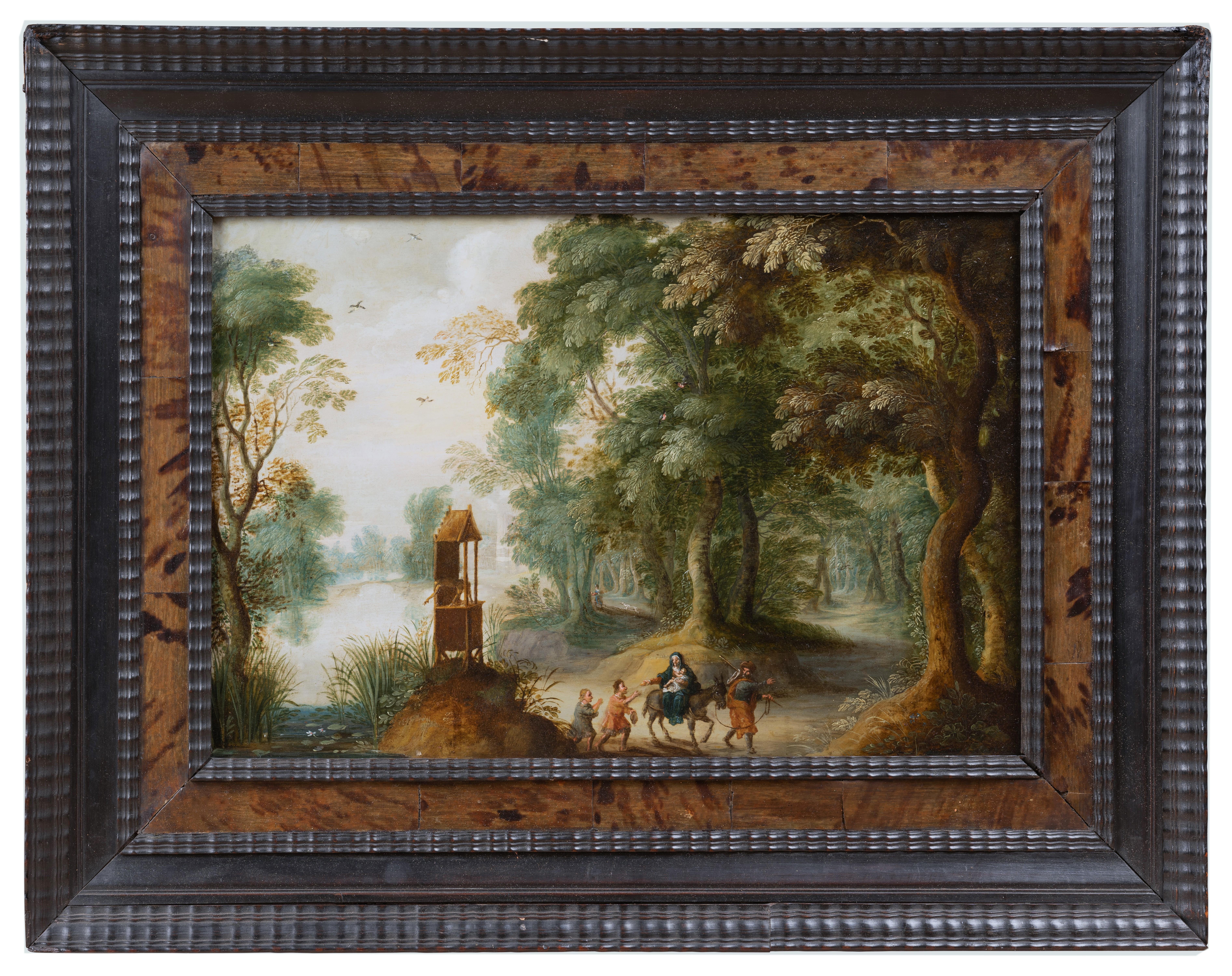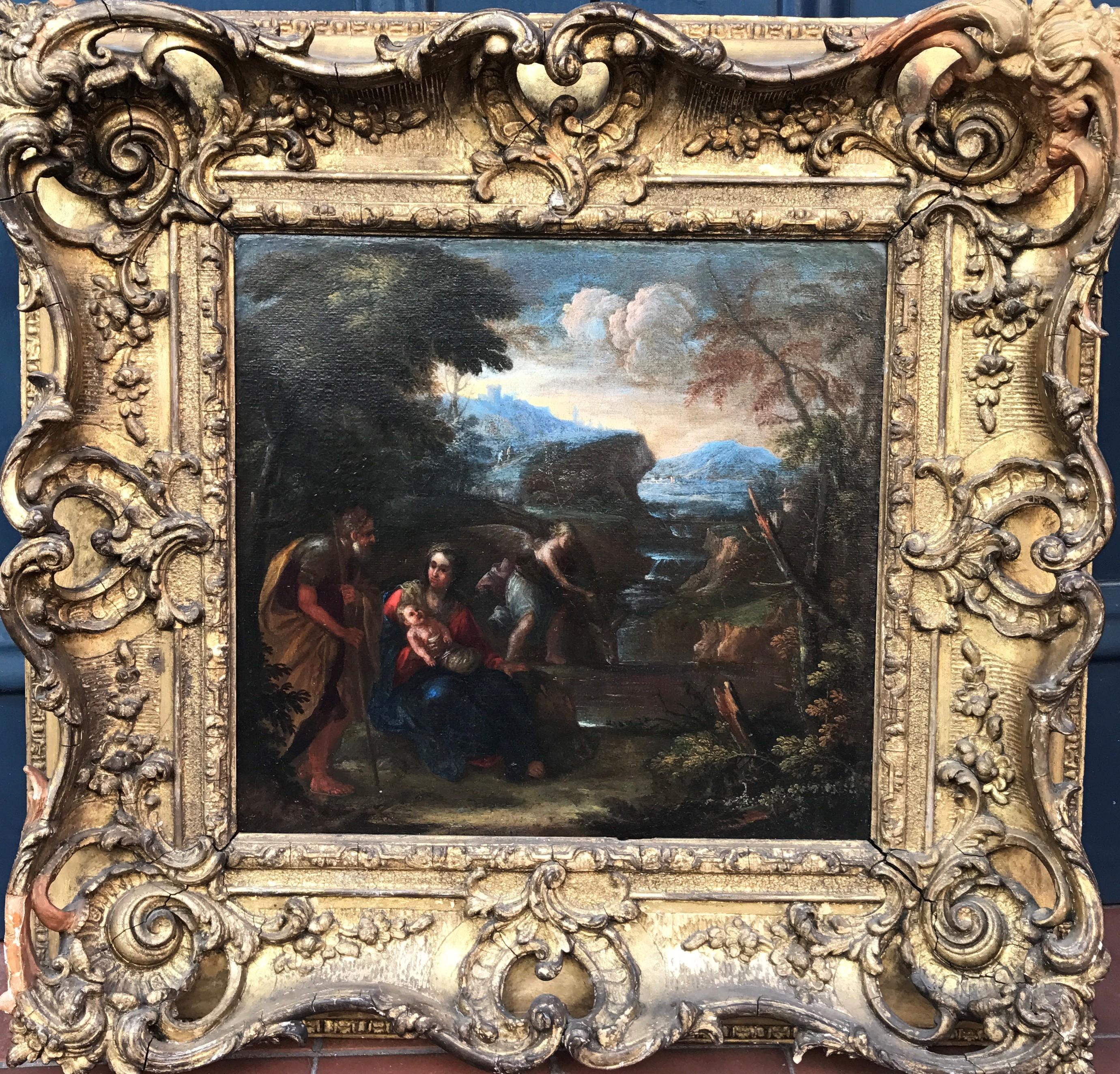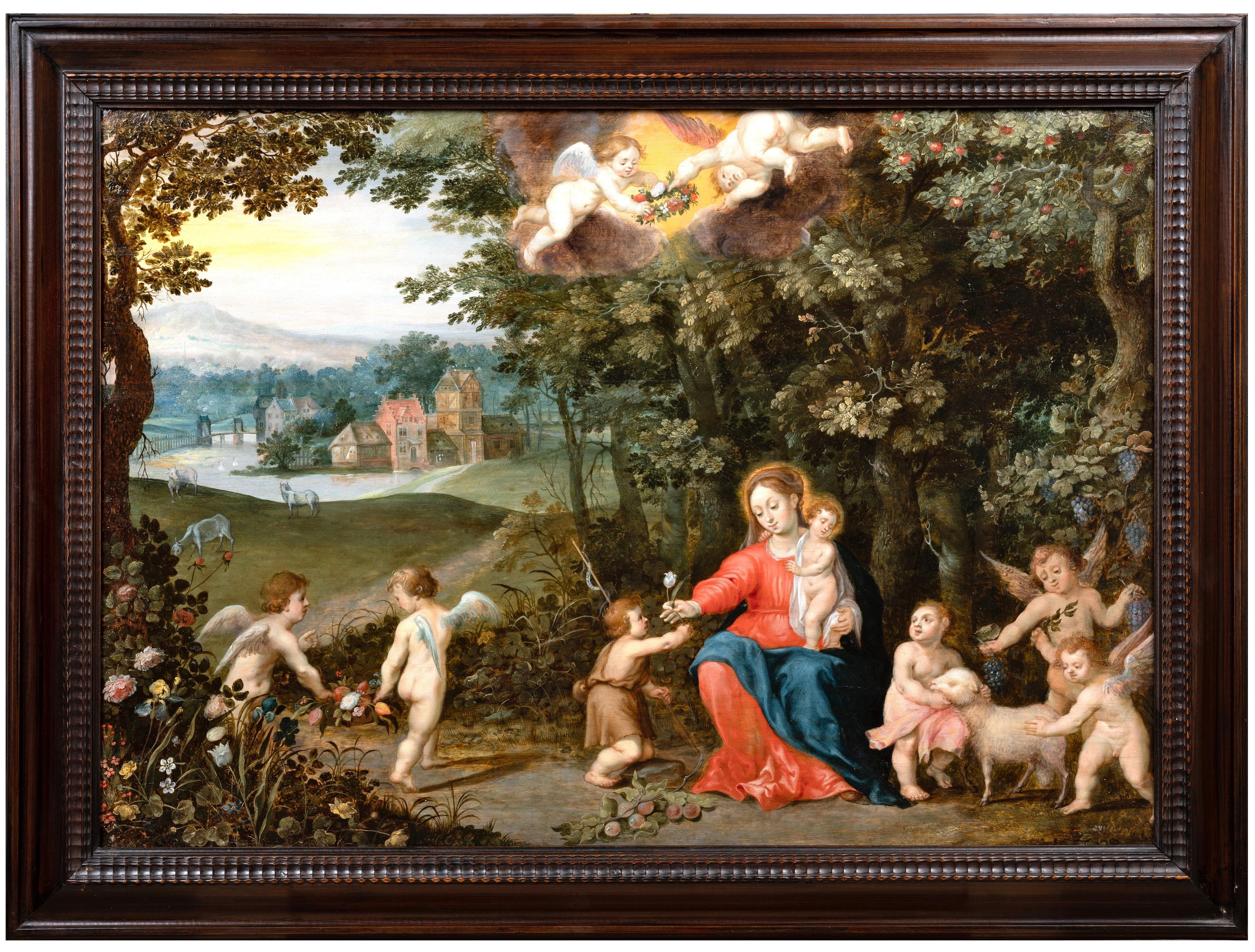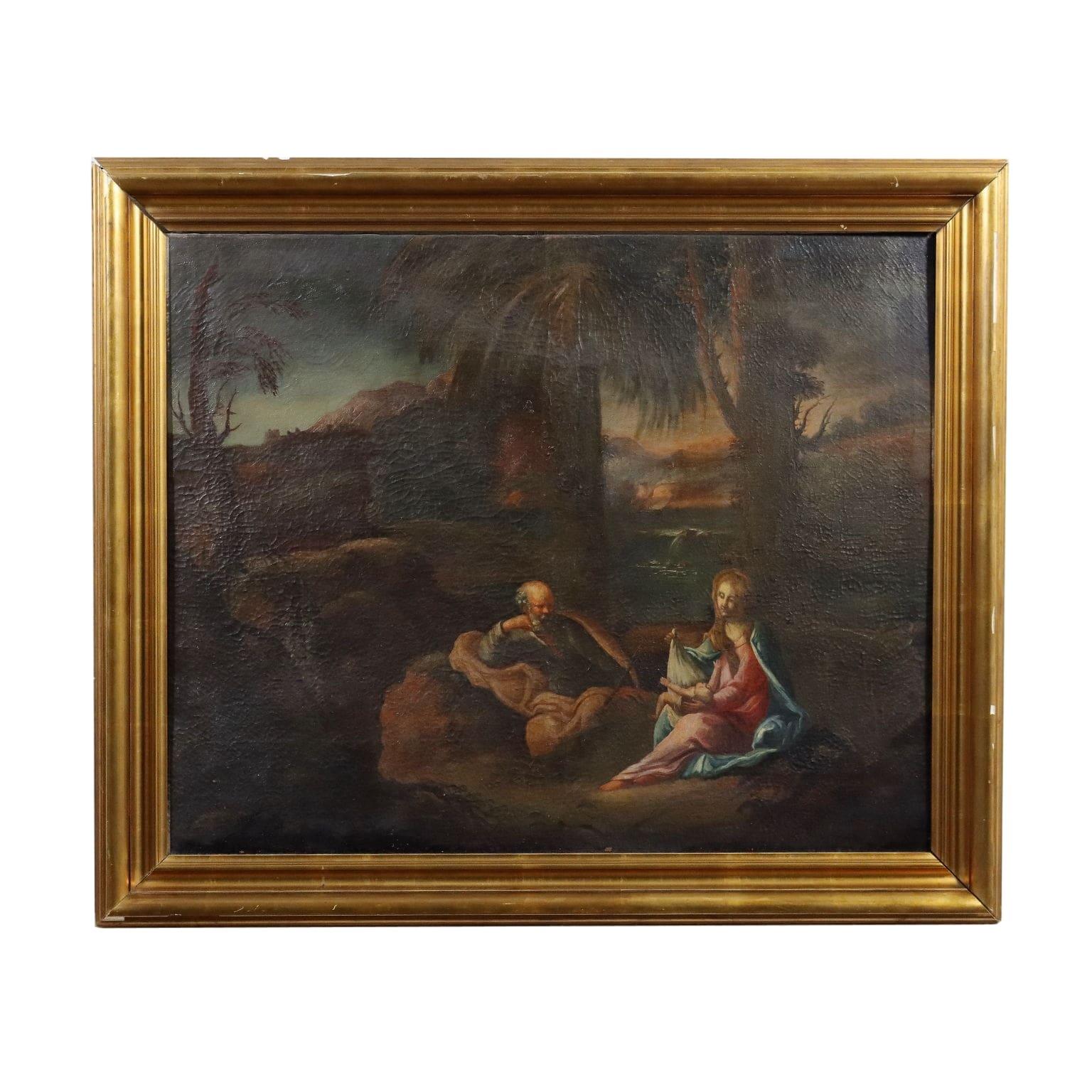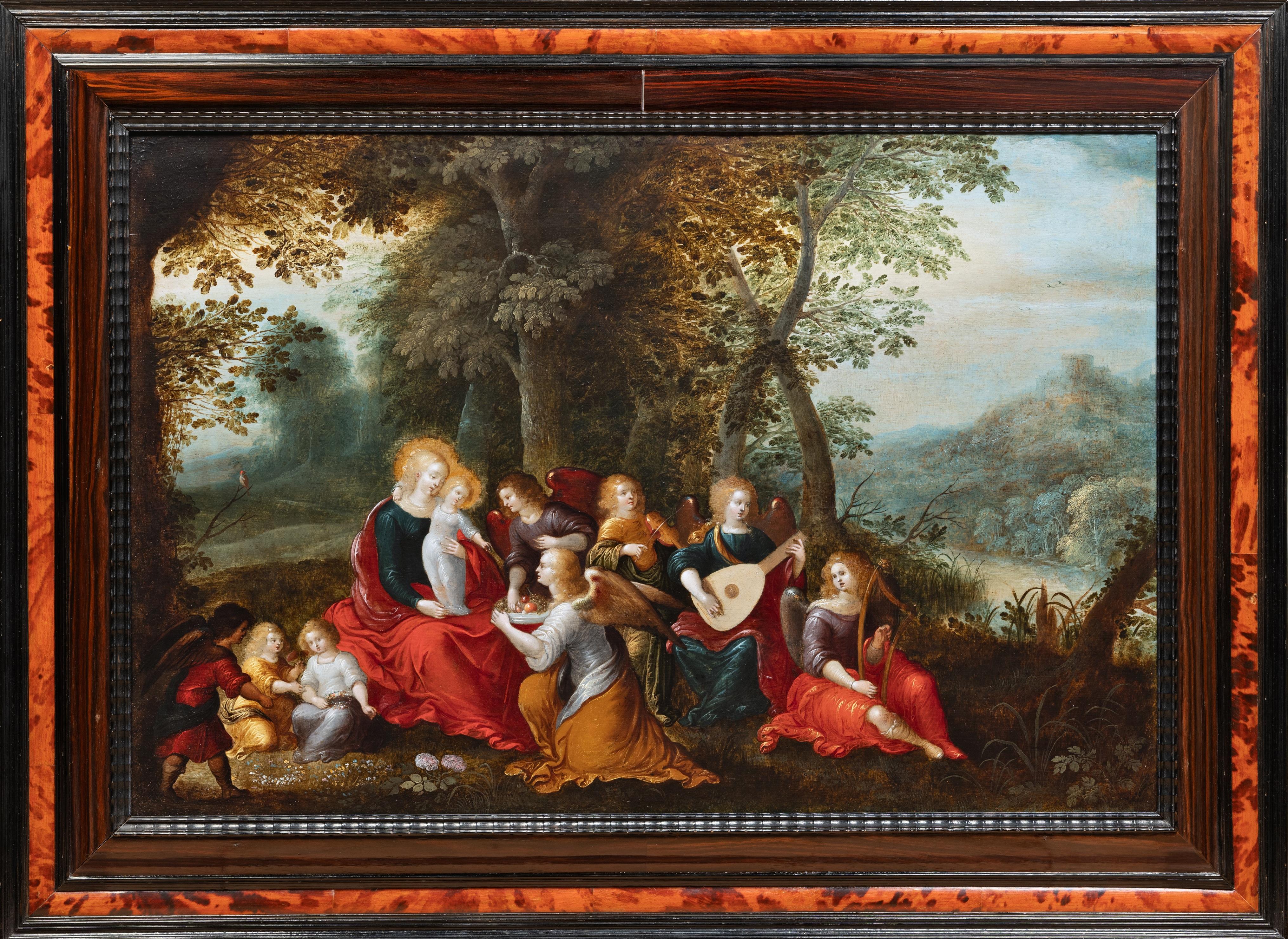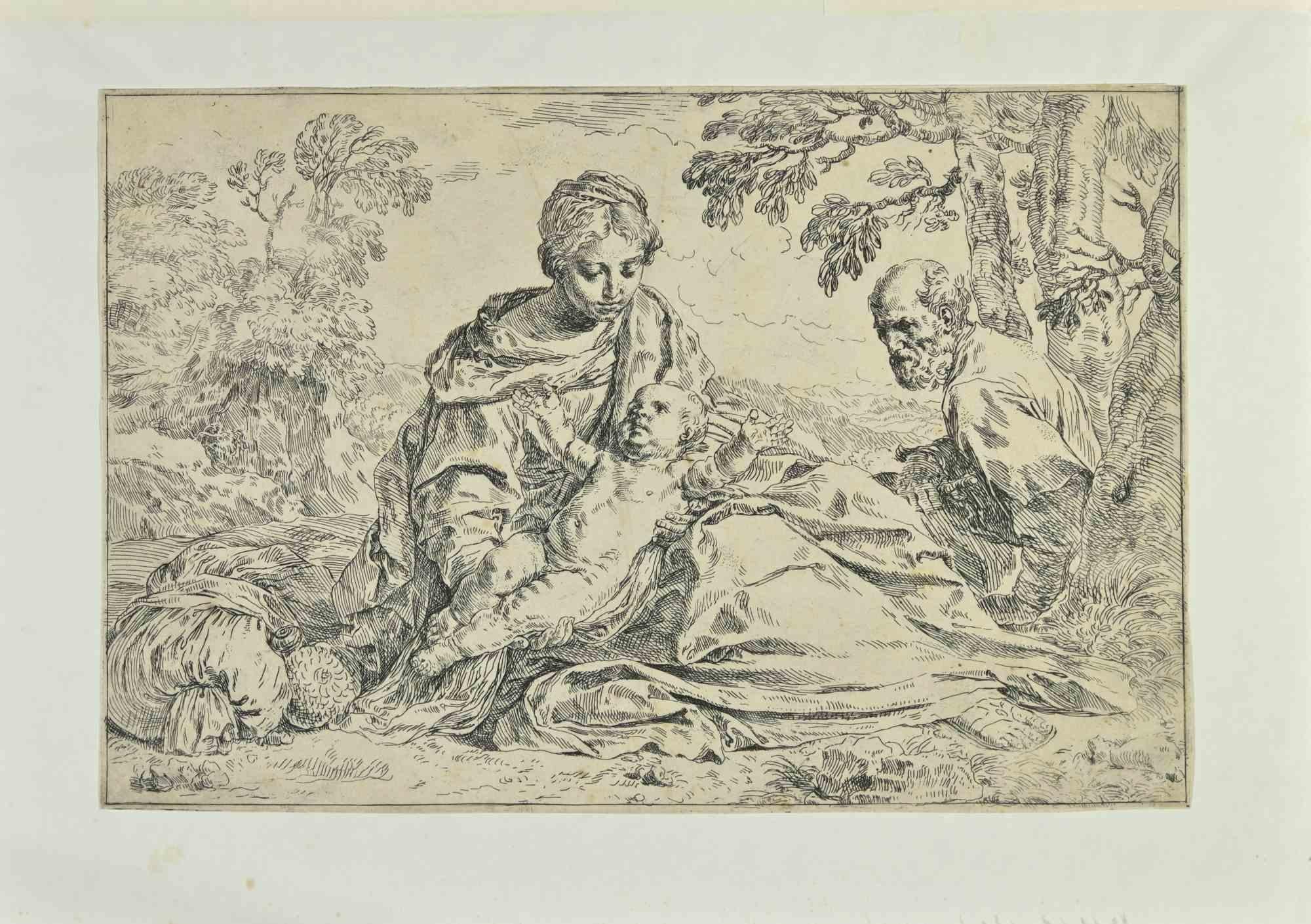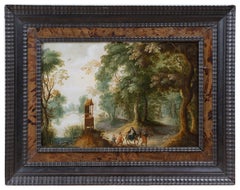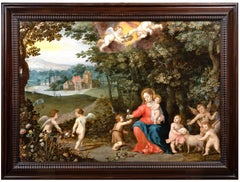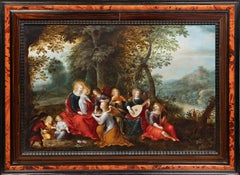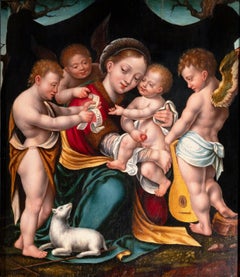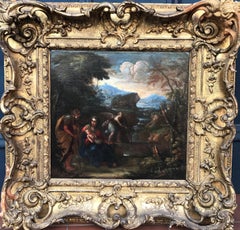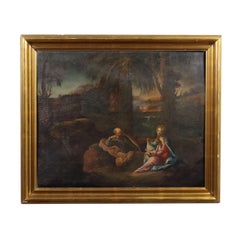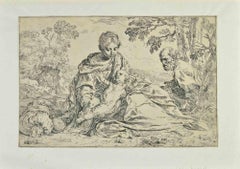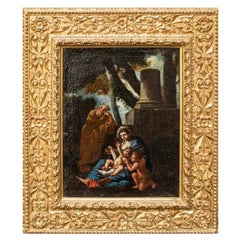Items Similar to Rest on the Flight into Egypt - Attributed to Pieter Van Avont - 17th c. Flemish
Video Loading
Want more images or videos?
Request additional images or videos from the seller
1 of 16
Rest on the Flight into Egypt - Attributed to Pieter Van Avont - 17th c. Flemish
$18,693.39
£14,201.67
€15,800
CA$26,267.11
A$28,846.46
CHF 14,849.06
MX$345,156.33
NOK 189,061.19
SEK 177,178.50
DKK 120,360.84
About the Item
Rest during the Flight into Egypt - The Virgin and Child with St. John the Baptist and the angels in a Landscape.
Attributed to Pieter Van Avont (1600-1652)
17th century Antwerp School, circa 1630
Oil on oak panel,
Dimensions: h. 38 cm, w. 50 cm (14.96 in x 19.68 in)
Flemish style frame in ebonized and moulded wood
Framed: h. 56 cm, w. 68.5 cm (22.04 in. x 26.97 in.)
In the heart of a lush wooded landscape, the Virgin with Jesus rests in a green clearing accompanied by Saint John the Baptist and the cherubs. Seated to the left of the composition, the Virgin Mary holds the Child on her lap; the little Saint John the Baptist wearing the camel-skin tunic (his attribute) stands before Jesus to exchange a few caresses. On the right, the couple of cherubs are playing with the lamb of Saint John the Baptist, bringing a jovial character to the scene. A pair of gardening putti on the left pick flowers to bring bouquets to the Virgin and Jesus. Spring flowers such as tulips, daffodils and anemones that grow abundantly around them and enrich the composition with their shimmering colors. A lush rose bush blooms to the left of the figures offering delicate roses. (The rose is the flower associated with the Virgin Mary, who is the "mystical rose," the one that does not bear the "thorn of sin")
At the feet of the Virgin are bunches of grapes (symbol of the future passion of Christ) as well as apples (symbol of the original fall of Man but also of the Redemption in Christ) In the foreground we find a wicker basket filled in profusion with beautiful flowers and guinea pigs nibbling on the blades of grass. In a cleverly arranged disorder, these elements of the still life with their strong symbolic power accentuate the religious theme, but are also an opportunity for the artist to demonstrate his know-how in the still life genre that is gaining momentum in Antwerp. The landscape behind the figures consists of a large tree with a twisted trunk and a luminous opening to the horizon placed on the right. We see Saint Joseph arriving with a donkey, a small reminder from the artist that the composition is associated with the episode of Rest during the flight into Egypt.
The calm expanse of this bucolic forest opening onto the luminous distance, with its profusion of symbolic flowers and fruits, is particularly suited to this sacred scene. The theme of Jesus' sacrifice and his tragic fate is mitigated by cherubs who play with innocence and carelessness in the face of the fragility of life symbolized by cut flowers. The great mastery of the painter is manifested by the finesse of the drawing enhanced by the delicacy in the application of the brushstrokes bringing a multitude of details. The richness of the whole is exacerbated thanks to the choice of colours, this varied palette is an undeniable asset of our work.
The virtuosity of our artist lies in his versatility, as much concerned with the success of the landscape and flowers as with the modelling of his figures. The cherubs with their naked bodies are gracefully illuminated by warm colours with subtle shadows, while the still life is rendered with astonishing realism, both in the precision of the drawing and in the countless shades of the flowers.
There are several compositions similar to ours, of which below are the closest versions:
• Sale, Jean-Claude Anaf et Associés, Lyon, 08/02/1998, attributed to Pieter Van Avont, oil on panel, h. 48 cm, l. 71 cm (recorded on RKD n° 31451). Comment: identical composition, only St Joseph with the donkey is different)
• Christie's New York sale, 29/01/1998, Pieter Van Avont, oil on copper, h. 23.8 cm, w. 24.8 cm
• Dorotheum sale, Vienna, 25/04/2017, Pieter Van Avont and Jan Breughel II, oil on copper, h .26 cm, w. 39 cm
• Hermitage Museum, Saint Petersburg, Russia, Pieter Van Avont, oil on panel, h. 50.5 cm, w. 71.7 cm
Peter van Avont, Flemish painter (Mechelen, 1600 - Antwerp. 1652)
Born in Mechelen, he is mentioned in 1620 as a member of the painters' guild of his hometown. He left in 1 622 for Antwerp, where he was also a member of the guild. He collaborated with many painters, including Jan Brueguel the Younger, David Vinckboons, Lucas van Uden, Jacques d'Arthois, Lucas Achtschellinck, Lodewijk de Vadder, Izaak van Oosten and Jan Wildens. The painter is known for his paintings with mythological and religious scenes. One of the main features of his work is the group of naked children. In his many versions of the Holy Family, they appear in the various roles: baby Jesus, St. John the Baptist, and the angels. They often bring offerings to the Virgin and Jesus. His figures with warm colors and delicate modeling are often depicted in landscapes of great finesse, which he executed himself, but also in collaboration with other artists...
- Attributed to:Pieter van Avont (1600 - 1652, Flemish)
- Dimensions:Height: 22.05 in (56.01 cm)Width: 26.97 in (68.51 cm)
- Medium:
- Movement & Style:
- Period:
- Condition:Very good original condition, cleaned and revarnished by our professionnal art restorer.
- Gallery Location:PARIS, FR
- Reference Number:1stDibs: LU2433213422372
About the Seller
No Reviews Yet
Vetted Professional Seller
Every seller passes strict standards for authenticity and reliability
1stDibs seller since 2023
17 sales on 1stDibs
- ShippingRetrieving quote...Shipping from: PARIS, France
- Return Policy
More From This Seller
View All17th c. Flemish - Landscape with Flight to Egypt - Antwerp circa 1630
Located in PARIS, FR
LANDSCAPE WITH FLIGHT TO EGYPT,
JASPER VAN DER LANEN (ANTWERP, 1585 - 1634)
17TH CENTURY FLEMISH SCHOOL
ANTWERP CIRCA 1630
Oil on copper, dimensions: h. 10.23 in, w. 14.96 in
Flemish style frame in ebonized wood adorned with wavy moldings and wood veneer.
Framed dimensions: h. 17.32 in, w. 21.65 in
Provenance:
Philips auction...
Category
Early 17th Century Old Masters Figurative Paintings
Materials
Copper
$9,524 Sale Price
30% Off
17th c. Antwerp studio of J. Brueghel & H. van Balen - The Virgin with Child
Located in PARIS, FR
Workshop of Jan Brueghel the Younger (1601-1678) & Hendrick van Balen (Antwerp, 1575 – 1632)
17th century Antwerp School
The Virgin and Child ...
Category
1630s Old Masters Figurative Paintings
Materials
Oil
Madonna and Child with Angels, attributed to Louis de Caullery, Flemish, 17th c.
Located in PARIS, FR
Madonna and Child with Angels
Attributed to Louis de Caullery (1565 -1622) for figures & Abraham Govaerts (1589 - 1626) for landscape
Not signed
17th century Antwerp school, circa 16...
Category
Early 17th Century Old Masters Figurative Paintings
Materials
Copper
Madonna and child with angels, circle of Joos Van Cleve, 16th c. Antwerp school
By Joos van Cleve
Located in PARIS, FR
Madonna and Child with Saint John the Baptist and angels
Circle of Joos Van Cleve (1485 – 1541)
16th century Antwerp school
Oil on oak panel
Dimensions: h. 32 cm (13 in.), w. 28.5 cm...
Category
16th Century Old Masters Figurative Paintings
Materials
Oil, Oak
Flemish 17th c., Allegory of war and peace, circa 1630, by Adriaen van Stalbemt
Located in PARIS, FR
Adriaen van Stalbemt (Antwerp, 1580-1662)
Allegory of Peace and War, circa 1620-1630
Oil on oak panel: h. 49.5 cm, l. 73.2cm (19.29 x 28.74 in)
Giltwood ...
Category
Early 17th Century Old Masters Figurative Paintings
Materials
Oil, Panel
Cercle of Ambrosius Francken, Adoration of the shepherds, 17th century Antwerp
Located in PARIS, FR
Adoration of the shepherds,
Cercle of Ambrosius Francken,
Early 17th century Antwerp school
Oil on oak panel: h. 55 cm, w. 43 cm (21.65 in x 16.93 in)
17th c. ebonized and moulded f...
Category
Early 17th Century Old Masters Figurative Paintings
Materials
Oil, Wood Panel
You May Also Like
17th Century Old Master Religious Oil painting - Rest on the Flight into Egypt
By Pier Francesco Mola
Located in London, GB
Attributed to Pier Francesco MOLA, called Il TICINESE (1612-1666)
Rest on the Flight into Egypt
oil on canvas
25.5 x 27 inches including ...
Category
Mid-17th Century Baroque Figurative Paintings
Materials
Oil
Rest on the Flight into Egypt Oil on Canvas XVIII-XIX Century
Located in Milan, IT
Oil painting on canvas. XVIII -XIX century. The sacred theme in this scene takes on a familiar connotation, full of very earthly tenderness and intimacy: in an almost exotic context, which evokes an oasis in the desert...
Category
Late 18th Century Other Art Style Figurative Paintings
Materials
Oil
Rest on the flight into Egypt - Etching by Simome Cantarini - 1640 ca
Located in Roma, IT
Rest on the flight into Egypt is an etching by Simone Cantarini executed around 1640. Cantarini also made a painting with the same subject now at the Louvre Museum.
The dimension...
Category
1640s Old Masters Figurative Prints
Materials
Etching
17th Century Rest on The Flight to Egypt Emilian school Painting Oil on Canvas
Located in Milan, IT
17th century, Emilian school
Rest on the flight to Egypt
Oil on canvas, 42 x 33 cm
Frame 65 x 55 cm
The present Holy Family, ...
Category
Antique 17th Century Italian Paintings
Materials
Canvas
17th Century Rest on the flight to Egypt Emilian School Painting Oil on panel
By Parmigianino
Located in Milan, IT
17th century, Emilian school, Pamigianino painter
Rest on the flight to Egypt
Oil on panel, 46 x 39 cm - with frame 55.5 x 48.5 cm
The wor...
Category
Antique 17th Century Italian Paintings
Materials
Wood
17th Century Oil on Panel Flemish Religious Painting Madonna with Child, 1670
Located in Vicoforte, IT
Antique Flemish panel from the first half of the 17th century. Oil painting depicting a splendid Madonna with child inside a niche surrounded by a garland of masterfully painted flow...
Category
1670s Figurative Paintings
Materials
Oil, Wood
$8,518 Sale Price
20% Off
More Ways To Browse
Oil Painting Of Mary And Jesus
Falling Man
Antique Baby Jesus
Flemish Landscape Painting
Flight Into Egypt
Springer Tulip
Framed Egyptian Art
Rest On The Flight Into Egypt
Landscape Oil Painting Egypt
Lucas Van Uden
Oil 1918
Oil Paintings Virginia
Rainbow Landscape
19th Century Dutch Romantic Oil Paintings
Brooklyn Oil Painting
C Inness Oil Paintings
Lakeside Paintings
Moody Landscape Painting
